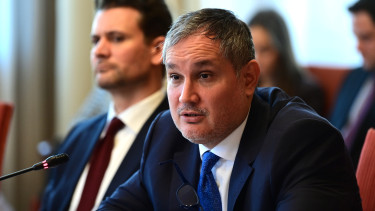Hungary to further ease curbs - Let's focus on stats other than the vaccination rate!

In only ten days, the number of people with coronavirus infection in Hungarian hospitals halved, and so did the number of those requiring mechanical ventilation. This is shown on the left-hand chart below.
The right-hand chart, however, shows that while only 1.5% of active cases are in hospital, as opposed to 2.2% on 1 May and as high as 6.5-6.7% in March,
there are still about 12% of COVID-19 patients in hospitals on ventilators.
There are now less than 2,000 people with coronavirus infection in hospitals and this ratio is the same when there were over 12,000!
Their number relative to the number of coronavirus patients in hospitals does not decline because many patients who are not in a life-threatening situation get discharged while those that stay are the severe cases and more and more of them are then hooked up to ventilators. The more serious cases are in hospitals, the higher the orange line will rise. The extreme case is 100% when every COVID-19 patient in hospital requires artificial ventilation.
As of 20 May, there were 1,645 people with COVID-19 in hospitals, with 195 of them on ventilators. On 1 May the respective figures were 5,031 and 587.

The seven-day averages show the very same pattern.

At the height of the pandemic, only about 2-2.5 months ago, about 7% of those that were diagnosed with COVID-19 were in such severe condition that they had to be hospitalised. This ratio is currently down at 1.6%, which is extremely low, especially because the UK variant (B.1.1.7) is not only more infectious but also causes more severe symptoms. But this has a lot to do with a considerable underdetection rate, the testing practices and the extremely low number of tests in general.
Projection vs. reality
We projected at the end of April that while the number of people with coronavirus infection in hospitals could drop considerably over the following two to three weeks, their ratio to the number of active cases would not decline to the same degree, given that the number of recovered people would also rise.
- COVID-19 patients in hospital --- 29 April: 5,550; Projection for 13 May: 2,800; Actual: 2,782
- In hospital / Active cases --- 29 April (7-day average): 2.6%; Projection for 13 May: 1.5-2.0%; Actual: 1.8%.
The peaks, according to the chart above, were in October 2020 and mid-March 2021. In other words, those were the end of health care capacities when everyone that needed hospitalisation had room in one of the institutions.
Currently the whole health care system is trying to return to business as usual, and they keep sending home COVID-19 patients whose lives are no longer at risk to continue their recovery at home. The green line will keep falling until another ‘wave’ hits.
A fourth wave is a real possibility, and red flags have been raised due to the re-opening measures a lot of experts deemed premature.
Testing versus... everything
The five charts below show that the fewer tests authorities perform, the higher the number of recovered people goes and the lower the number of active cases goes.

The overlap on the first chart starting in end-March, early April (the number of active cases dropping and the number of recovered people going up) was caused mainly by GPs registering people with COVID-19 as recovered. Also, the higher the number of COVID-19 go, the more overlapping these ’ridges’ will become, because they are no longer in the log of active cases but they are (obviously) not in recovered status either.
And here's the same with 7-day rolling averages.

The following two charts show the same set of figures, only the yellow area on the one on the right, depicting the number of people that recovered from COVID-19, is from top to bottom.
The trend on the right-hand chart is clear: the more tests they perform (blue), the lower the number of recoveries go (yellow). The same phenomenon can be seen on the first chart, by the way, only in the form of ‘ridges’ running parallel with each other up to April. Then there’s a sharp divergence. One of the ridges becomes a precipice, the other turns into a steeply ascending cliff.

This abrupt change is shown on the third chart by the yellow line skyrocketing to over 58% from 5% over less than 1.5 months.
Our hypothesis is that most of the daily tests are done on samples taken from people waiting to be discharged from hospitals, while authorities are also trying to perform as few tests as possible, i.e. only those that show severe symptoms get tested for COVID-19.

They walk among us…
Two in one. Two charts, one set of data. Hungarians vs. quarantine. How many people in active status walk among us. A lot, apparently.
Accoring to 7-day averages, there are about 130,000 active COVID-19 cases in Hungary currently, of whom fewer than 17,000 people are in mandatory quarantine. That is 13%, a staggeringly low figure.
More than 100,000 people can freely decide if they want to stay home or pop out for a sixpack or a loaf of bread to the grocery store or watch a movie in the cinema. It’s totally up to them.
Anyone of the cc. 80% of the remaining 113,000 people in active status could potentially be standing behind you at the cashier or sitting behind you in the cinema / theater. That's not a pleasant thought. (Note that 2-5% are in hospital, and the rest are in mandatory quarantine).
The charts are based on absolute figures and show a ratio, as well. All data are 7-day averages.
The chart on the left is for the period between 1 August 2020 and 17 May 2021, while the one on the right-hand side spans from 1 October 2020 to 17 May 2021, because the decline of the ratio showing the number of people in mandatory quarantine divided by the number of active COVID-19 cases dropped so sharply from Sept to mid-Oct that it cannot be seen on the left-hand chart.

About the vaccination programme
As of 20 May, the number of people vaccinated with the first dose is 4,898,866, and 2,886,292 of them have already got the second jab as well. Vaccination coverage has now reached 50% in Hungary. The vaccination drive has picked up pace perceptibly in recent days, probably due to the arrival of further Pfizer shipments. In the past 24 hours, nearly 70,000 first and 71,000 second doses were administered.
Hungary’s government decided on Wednesday not to join the next round of EU COVID vaccine orders. One of the reasons is that Hungary would only be able to order Pfizer’s vaccine and would have to pay HUF 120 billion for 19 million doses.
Hungary is the only EU country that opted out of the new vaccine deal signed with Pfizer and BioNTech for the supply of up to 1.8 billion doses of their COVID-19 jab
Even if a booster was needed, “there are plenty of vaccines from Eastern and Western sources as well,” Gergely Gulyas, Prime Minister Viktor Orbán’s chief of staff, told a news conference on Thursday.
Orbán told public radio MR1 on Friday morning that on top of the vaccines already administered, Hungary has either in stock or in the process of ordering 7.3 million doses of Pfizer/BioNTech, 1.2 million doses of Janssen, 4 million doses of Moderna, and 4.7 million doses of AstraZeneca COVID-19 vaccines, said the PM.
These are sufficient to administer third or even fourth doses
, he added.
The plan for the longer term is for us to become self-reliant. The vaccine plant in Debrecen is to start production by the end of 2022 at the latest, and it will manufacture a locally-developed COVID-19 vaccine, said Orbán.

Cover photo: koronavirus.gov.hu






